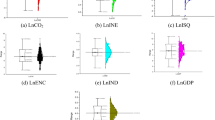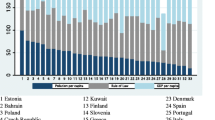Abstract
The paper examines the relationship between poverty and CO2 emission. We contribute by using a global panel data of 146 countries over the period 1996–2014 and by focusing on the role of institution in poverty and environmental degradation nexus. The main findings are that the non-linearity relationship between poverty and CO2 emission could prompt a further increase in the poverty and environmental degradation. However, an increase in the institutional quality leads to a reduction in poverty and more protection to the environment. The main policy recommendation is that all countries need to improve their institutional framework so that reduction of poverty and environmental degradation can occur.
Similar content being viewed by others
Notes
The years 1997, 1999, and 2001 have been excluded because there is no available data for Kaufman indicators in these years.
Kaiser criterion suggests keeping the principal components that have an eigenvalue more than 1.
The literature shows other measures of poverty such as the Human Poverty Index (HPI) and the Multidimensional Poverty Index (MPI). HPI is a composed indicator used by the United Nations to capture the poverty from different sides. Since 2010, this indicator is replaced by MPI. The access to the HPI data is no longer available and the MPI data do not cover the period used in this paper. In addition, these kinds of composite indicator may lead to collinearity in the regression analysis.
According to the literature, the Human Development Index (HDI) is a more complete indicator of human development. However, the index is highly correlated to our variables; thus, we control only its health dimension by the use of life expectancy at birth.
The GDP per capita could be the good variable to be used but it appears highly correlated to almost of our variables, so we use lnGDP to ovoid multicollinearity.
Degenerative corruption is a term used by Wedeman (2012) to describe a corruption that can have a potentially catastrophic effect. However, he used the term “developmental corruption” to describe corruption that can have a less catastrophic effect.
References
Abid M (2016) Impact of economic, financial, and institutional factors on CO2 emissions: evidence from sub-Saharan Africa economies. Util Pol 41:85–94
Abou-ali H, Abdelfattah YM (2013) Integrated paradigm for sustainable development : a panel data study. Econ Model 30:334–342
Acemoğlu D, Johnson S, Robinson JA (2001) The colonial origins of comparative development: an empirical investigation. Am Econ Rev 91(5):1369–1401
Acemoğlu D, Johnson S, Robinson JA (2005) Chapter 6: institutions as a fundamental cause of long-run growth, In: Philippe Aghion and Steven N. Durlauf, editor(s), Handbook of economic growth, Elsevier, vol 1 part a, 385–472
Acemoğlu D, Robinson JA (2011) Why nations fail: the origins of power, prosperity and poverty. Crown Publishing Group, London
Aron J (2000) Growth and institutions: a review of the evidence. World Bank Res Obs 15(1):99–135
Atkinson G & Hamilton K (2003) Savings, growth and the resource curse hypothesis. World development 31(11):1793–1807
Barnes DF, Krutilla K, Hyde W (2005) The urban household energy transition: social and environmental impacts in the developing world. Resources for the Future S, Routledge
Burton E (2000) The compact city: just or just compact? A preliminary analysis. Urban Stud 37(11):1969–2006
Capello R, Camagni R (2000) Beyond optimal city size: an evaluation of alternative urban growth patterns. Urban Stud 37(9):1479–1496
Cavendish W (2000) Empirical regularities in the poverty-environment relationship of rural households: evidence from Zimbabwe. World Dev 28(11):1979–2003
Chong A, Gradstein M (2007) Inequality and institutions. Rev Econ Stat 89(3):454–465
Cole M (2007) Corruption, income and the environment: an empirical analysis. Ecol Econ 62:637–647
Cole M, Neumayer E (2004) Examining the impact of demographic factors on air pollution. Popul Environ 26(1):5–21
Costantini V, Monni S (2008) Environment, human development and economic growth. Ecol Econ 64:867–880
Culas RJ (2007) Deforestation and the environmental Kuznets curve: an institutional perspective. Ecol Econ 61:429–437
Davidson R & MacKinnon JG (1993) Estimation and inference in econometrics. OUP Catalogue.
Dinda S (2004) Environmental Kuznets curve hypothesis: a survey. Ecol Econ 49:431–455
Duraiappah AK (1998) Poverty and environmental degradation: a review and analysis of the nexus. World Dev 26(12):2169–2179
Ebenstein A (2012) The consequences of industrialization: evidence from water pollution and digestive cancers in China. Rev Econ Stat 94(1):186–201
Fan Y, Liu L-C, Wu G, Wei Y-M (2006) Analyzing impact factors of CO2 emissions using the STIRPAT model. Environ Impact Assess Rev 26(4):377–395
Farzin YH, Bond CA (2006) Democracy and environmental quality. J Dev Econ 81:213–235
Gagliardi F (2008) Institutions and economic change: a critical survey of the new institutional approaches and empirical evidence. J Soc Econ 37:416–443
Grindle MS (2004) Good enough governance: poverty reduction and reform in developing countries. Governance 17(4):525–548
Grossman G, Krueger AB (1991) Environmental impacts of a north American free trade agreement. National Bureau of Economic Research Working Paper Series, No 3914:1–57
Holtz-Eakin D, Selden T (1995) Stoking the fires? CO 2 emissions and economic growth. J Publ Econ 57:85–101
Isham J, Woolcock M, Pritchett L, Busby G (2005) The varieties of resource experience: natural resource export structures and the political economy of economic growth. World Bank Econ Rev 19(2):141–174
Jalal K (1993) Sustainable development, environment and poverty nexus. Asian Development Bank
Jodha N (1998) Poverty and environmental resource degradation: an alternative explanation and possible solutions. Econ Polit Wkly 33(36/37):2384–2390
Judge G, Griffiths WE, Hill RC, Lutkepohl H, Lee T-C (1985) The theory and practice of econometrics, 2nd edn. Wiley, New York, pp 477–478
Kaiser HF (1960) The application of electronic computers to factor analysis. Educ Psychol Meas 20:141–151
Kaufmann D, Kraay A, Mastruzzi M (2004) Governance matters III : governance indicators for 1996, 1998, 2000, and 2002. World Bank Econ Rev 18(2):253–287
Kelly TJ, wa Gîthînji M (1994) Enviromental degradation and poverty in less industrialized nations. Frontera Norte, (77–90)
Khan SR, Khan SR (2009) Assessing poverty-deforestation links: evidence from swat, Pakistan. Ecol Econ 68:2607–2618
Kraay A, Mastruzzi M, Kaufmann D (2003) Governance Matters III: Governance Indicators for 1996–2002. Informe de investigación No. WPS, 3106
Kwon HJ, Kim E (2014) Poverty reduction and good governance: examining the rationale of the millennium development goals. Dev Change 45(2):353–375
Lau L-S, Choong C-K, Eng Y-K (2014) Carbon dioxide emission, institutional quality, and economic growth: empirical evidence in Malaysia. Renew Energ 68:276–281
Leach M, Mearns R, Scoones I (1999) Environmental entitlements: dynamics and institutions in community-based natural resource management. World Dev 27(2):225–247
Leitão A (2010) Corruption and the environmental Kuznets curve: empirical evidence for sulfur. Ecol Econ 69(11):2191–2201
Lélé SM (1991) Sustainable development: a critical review. World Dev 19(6):607–621
Liddle B, Lung S (2010) Ge-structure, urbanization, and climate change in developed countries: revisiting STIRPAT for disaggregated population and consumption-related environmental impacts. Popul Environ 31(5):317–343
López R, Mitra S (2000) Corruption, pollution, and the Kuznets environment curve. J Environ Econ Manag 40:137–150
Lopez JH (2004) Pro-growth, pro-poor: is there a tradeoff. World Bank Publications
Martínez-Zarzoso I, Bengochea-Morancho A, Morales-Lage R (2007) The impact of population on CO2 emissions: evidence from European countries. Environ Resour Econ 38:497–512
Martínez-Zarzoso I, Maruotti A (2011) The impact of urbanization on CO2 emissions: evidence from developing countries. Ecol Econ 70:1344–1353
McGranahan G (2001) The citizens at risk: from urban sanitation to sustainable cities. In: Earthscan risk in society. Routledge, London
Narain U, Gupta S, van’t Veld K (2008) Poverty and resource dependence in rural India. Ecol Econ 66:161–176
Nayak P (2010) Poverty and environmental degradation in rural India: a nexus. In Proceedings of the Annual Conference of NEEA Held at Dibrugarh
Ncube M, Lufumpa CL, Kayizzi-Mugerwa S (2011) The middle of the pyramid: dynamics of the middle class in Africa. African Development Bank Market Brief, No. 24
Newman PWD, Kenworthy JR (1989) Cities and automobile dependence: an international sourcebook. Gower Publishing, Aldershot
North DC (1990) Institutions, institutional change and economic performance. Economic development and cultural change. Cambridge University Press, New York
Özokcu S, Özdemir Ö (2017) Economic growth, energy, and environmental Kuznets curve. Renew Sustain Energ Rev 72:639–647
Panayotou T (1997) Demystifying the environmental Kuznets curve: turning a black box into a policy tool. Environ Dev Econ 2(4):465–484
Parikh J, Shukla V (1995) Urbanization, energy use and greenhouse effects in economic development. Glob Environ Chang 5(2):87–103
Poumanyvong P, Kaneko S (2010) Does urbanization lead to less energy use and lower CO2 emissions? A cross-country analysis. Ecol Econ 70:434–444
Prakash S (1997) Poverty and environment linkages in mountains and uplands: reflections on the ‘poverty Trap’ thesis. Environmental Economics Programme, International Institute for Environment and Development 12:36
Reardon T, Vosti SA (1992) Issues in the analysis of the effects of policy on conservation and productivity at the household level in developing countries. Q J Int Agr 31(4):380–396
Rigobon R, Rodrik D (2004) Rule of law, democracy, openness and income: estimating the interrelationships. NBER Working Paper 13(10750):533–564
Roca J, Padilla E, Farré M, Galletto V (2001) Economic growth and atmospheric pollution in Spain: discussing the environmental Kuznets curve hypothesis. Ecol Econ 39:85–99
Rodrik D, Subramanian A (2004) Institutions rule : the primacy of institutions over geography and integration in economic development. J Econ Growth 9:131–165
Rostami F, Sadati A (2008) Poverty alleviation and sustainable development: the role of social capital. J Soc Sci 4(3):202–215
Rudlin D, Falk N (1999) Building the 21st century home: the sustainable urban neighborhood. Architectural Press, Oxford
Scherr SJ (2000) A downward spiral? Research evidence on the relationship between poverty and natural resource degradation. Food Pol 25(4):479–498
Shafik N, Bandyopadhyay S (1992) Economic growth and environmental quality: time-series and cross-country evidence. World Bank Publications, 904
Sindzingre A (2005) Explaining threshold effects of globalization on poverty an institutional perspective. UNU-WIDER Working Paper No.2005/53, 5, 29–30
Subramanian A (2007) The evolution of institutions in India and its relationship with economic growth. Oxford Review of Economic Policy, 23(2):196–220
Swinton SM, Escobar G, Reardon T (2003) Poverty and environment in Latin America: concepts, evidence and policy implications. World Dev 31(11):1865–1872
Tamazian A, Bhaskara Rao B (2010) Do economic, financial and institutional developments matter for environmental degradation? Evidence from transitional economies. Energ Econ 32:137–145
Tebaldi E, Mohan R (2008) Institutions-augmented Solow model and Club convergence. MPRA Working Paper, (69672)
Tebaldi E, Mohan R (2010) Institutions and poverty. J Dev Stud 46(6):1047–1066
Perera LDH, Lee GHY (2013) Have economic growth and institutional quality contributed to poverty and inequality reduction in Asia? J Asian Econ 27:71–86
Wedeman A (2012) Double paradox: rapid growth and rising corruption in China. Cornell University Press, London
World Bank (1992) Development and the environment. World Development Report
York R (2007) Demographic trends and energy consumption in European Union nations, 1960-2025. Soc Sci Res 36:855–872
Author information
Authors and Affiliations
Corresponding author
Additional information
Responsible editor: Nicholas Apergis
Appendix
Appendix
Rights and permissions
About this article
Cite this article
Rizk, R., Slimane, M.B. Modelling the relationship between poverty, environment, and institutions: a panel data study. Environ Sci Pollut Res 25, 31459–31473 (2018). https://doi.org/10.1007/s11356-018-3051-6
Received:
Accepted:
Published:
Issue Date:
DOI: https://doi.org/10.1007/s11356-018-3051-6




